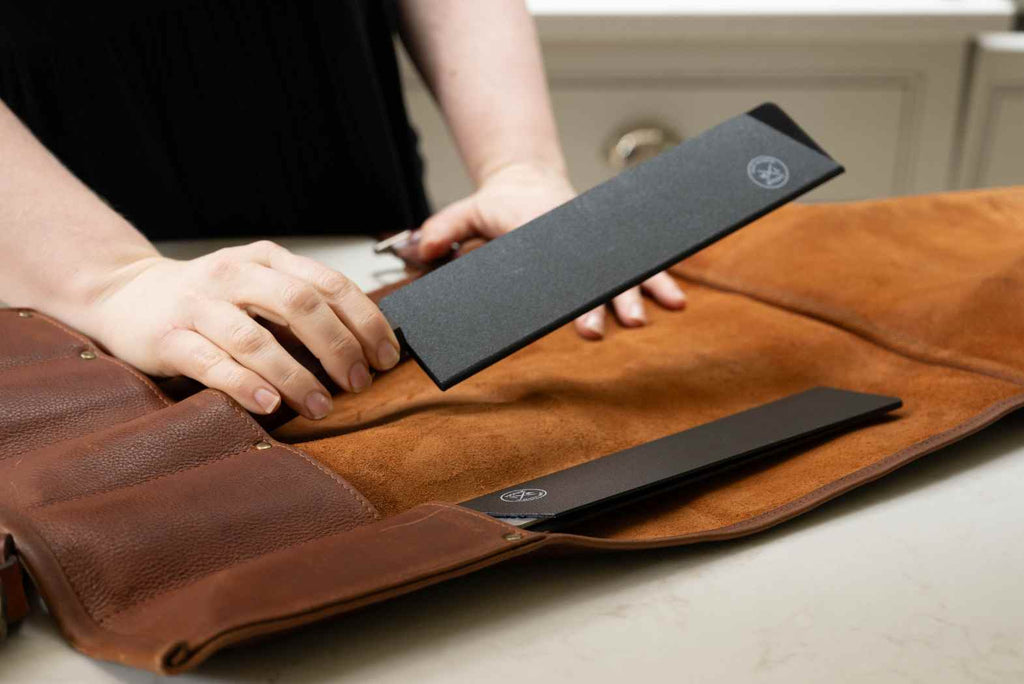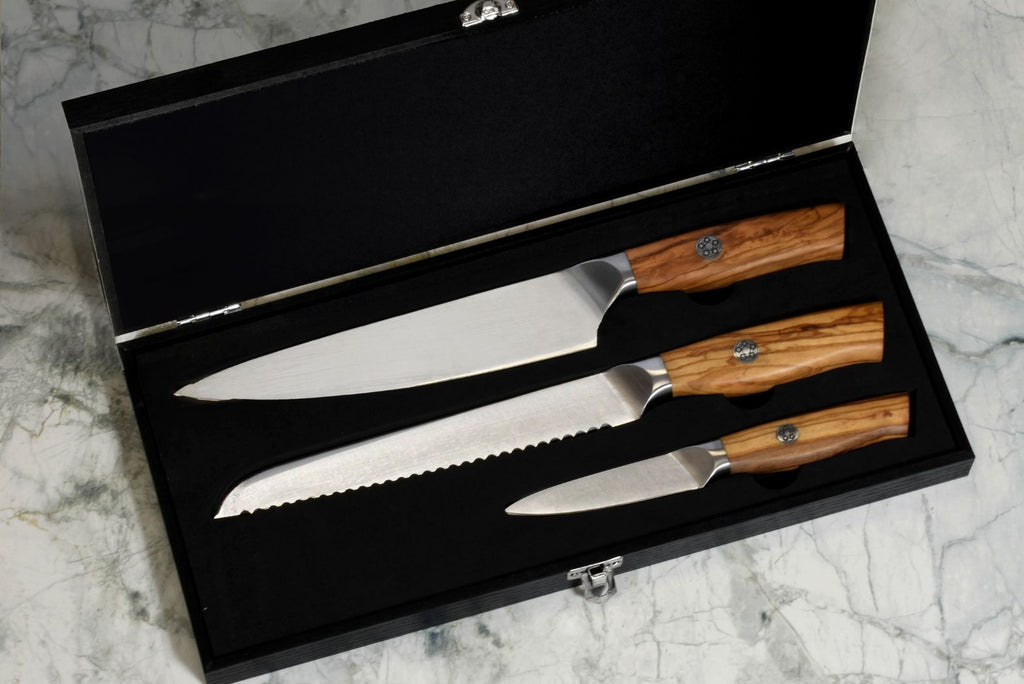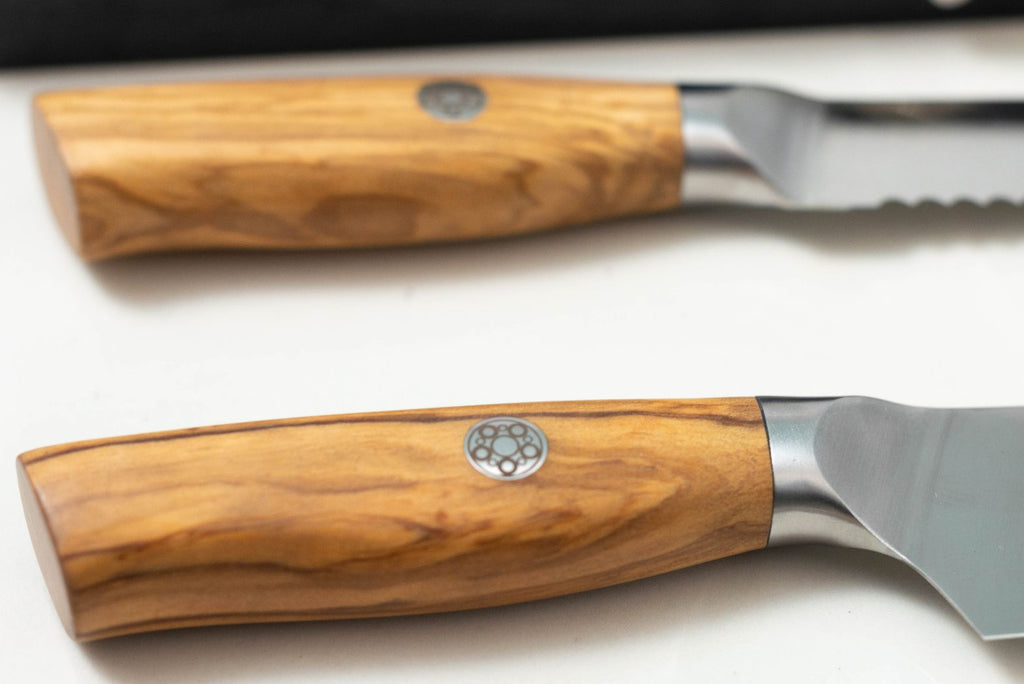How To Care For Your Kitchen Knife
by Kristin Lohse

Now that you've got the knife of your dreams, you need to know how to properly look after it. In this handy guide we will cover our top tips for keeping your knife sharp, as well as how to properly clean and store your new knife. Misuse or mistreatment of your knife will also void any warranty it may be covered by.
Sous Chef knife experts
In this guide, you’ll hear from Sous Chef buyer Kristin Lohse, who has many years of kitchen knife experience - and is a true expert in sharpening and caring for knives. And Sous Chef food editor Holly Thomson, who has been trained in knife skills by expert chefs and cookery teachers.
Plus Sous Chef founder Nicola Lando will share her insight and expertise. Nicola has worked in a Michelin kitchen, and knows first-hand which are the knives top chefs love. She also has over a decade of experience talking to knife makers, small producers and artisan kitchen knife brands, from around the world.
In this blog, we will discuss
- easy-to-follow steps for maintaining your knives' longevity and sharpness.
- The best chopping boards that ‘care’ for your kitchen knives with a gentle chopping surface.
- Finally, we’ll ask that age-old question: can kitchen knives go in the dishwasher. Read on to find out…
Become a kitchen knife expert, with our Ultimate Guide to Kitchen Knives.
To know more about kitchen knives, browse our kitchen knives collection.
Best chopping board for knives
Did you know that the chopping board you use, is one the the biggest ways you can care for your knife, day-to-day? Here, our in-house knife expert Kristin Lohse shares exactly which chopping boards are best for preserving your knife's sharpness.
Wooden boards
A favourite for many home cooks. Wooden chopping boards are gentle on knife edges, reducing dullness. Hardwoods like maple, walnut, or cherry are best. They resist cuts and are less prone to bacteria than softer woods.
“End-grain” wooden boards are even more gentle on knives. The wood is inherently softer when you’re chopping into cross-section of the grain. It helps for smoother cutting, keeping your knives sharp, and a long lasting board.
Teakhaus uses 100% sustainable wood from FSC® certified forests so that all of their products are truly eco-friendly. Teakwood's natural beauty combined with its high oil content and moisture resistance make it an ideal material for a cutting board. It is knife-friendly, easy to maintain and long-lasting.
Plastic boards
Easy to clean and affordable. Choose a high-quality, thick plastic that won’t warp. They’re dishwasher safe, making them a hygienic option if replaced regularly. You’ll often find plastic colour-coded boards in professional kitchen. Where each colour is used for a different ingredient, reducing cross-contamination.
Bamboo boards
A great sustainable choice. Bamboo is harder than most woods, yet still easier on knives than plastic or glass. It absorbs less moisture, preventing bacteria growth. But still has the softness of a wooden board.
Each type has its merits. Wooden and bamboo boards are best for knife longevity. They require more maintenance but reward you with aesthetics and durability.
Top Tip:
Sous Chef knife buyer Kristin says: “Plastic and composite boards are a great complement to a wooden board. I use my plastic board with raw meats or very strong ingredients, which can otherwise rub-off on a wooden board and leave a lingering flavour."
How to clean your knife

How should you clean your knife? Proper care keeps your knives in top shape, ensuring longevity and performance. Let’s look at the best practices for different types.
Stainless steel knives
Known for their resistance to rust and stains. Clean with warm, soapy water right after use. Dry immediately to prevent water spots and maintain the blade's integrity.
Carbon steel knives
Require more attention. Wash immediately after use to prevent rust. Avoid soaking in water. Dry thoroughly, and apply a light coat of oil to protect the blade.
Ceramic knives
Hard and brittle, yet easy to clean. Soap and water are enough. Use a soft sponge to avoid scratching. Dry well to keep its sharp edge.
Damascus steel knives
Characterised by their distinctive patterns. Wash by hand using gentle soap. Dry immediately to preserve the pattern and prevent rust.
Serrated knives
Their grooved edges can trap food. Use a brush to clean the grooves under running water. Dry well to protect the edge.
Can you put knives in the dishwasher?
No. For all kitchen knives, avoid the dishwasher. Harsh chemicals, heat, and potential for knocking against other items can damage knives. Plus the extremely high temperatures can melt any glue keeping your handle attached to the blade.
Instead, hand-wash knives gently and promptly after use.
Why shouldn’t I put my knife in the dishwasher?
Putting knives in the dishwasher is a common mistake. It seems convenient but can harm both the knife and dishwasher. Here’s more detail and information on why it’s a bad idea to put knives in the dishwasher:
- Dulls the edge. Jets of water push knives against racks and other items, leading to nicks and dullness. The dishwasher's harsh environment dulls knife blades.
- Corrosion risk. Dishwasher detergents are abrasive. They can cause corrosion and rust on knives, especially those made of carbon steel.
- Handle damage. Water temperature and detergent can damage knife handles. Materials like wood can warp, crack, or lose their finish. Plus glues may melt in the high temperatures - and your handle may detach from the blade.
- Safety hazard. Reaching into a dishwasher and touching a sharp blade can cause injury. It’s safer to wash knives by hand. Then place them immediately back in their block, rack or knife drawer.
Hand washing protects your knives. Use warm, soapy water and dry immediately. This preserves their sharpness, appearance, and longevity. Treat your knives with care, and they’ll serve you well for years to come.
How should I store my knives?
Storing knives properly is crucial for their longevity and your safety. Here's the right way to do it. Read our full guide on storing knives here.
- Knife block. A common choice. It keeps blades separated and protected. Ensure blocks are clean and dry to prevent bacteria growth.
- Magnetic strip. Saves counter space and allows easy access. Ensure it's installed away from high-traffic areas to avoid accidents.
- Drawer inserts. A safe option for drawer storage. Inserts keep knives organised and prevent them from touching, protecting their edges.
- Knife case or roll. Ideal for those with limited space or chefs on the go. They protect each knife individually, great for transporting.
Avoid loose storage in drawers. It’s dangerous and can damage the knives If storing in a drawer is your only option. Make sure to use knife/blade guards to protect the blades, other items in the drawer and your hands.
Whatever method you choose, ensure knives are clean and dry before storage. This maintains their condition and ensures your kitchen remains a safe environment. Proper storage is key to preserving the quality and sharpness of your knives.

How do you maintain a kitchen knife?
Maintaining a kitchen knife is key to ensuring it performs well and lasts long.
- Knife care starts with proper cleaning after each use. Drying your knife immediately after washing is just as important to prevent rust, especially for knives made from carbon steel.
- Regular honing keeps the knife’s edge aligned, which should be done every few uses. However, honing doesn't replace sharpening; using a whetstone a few times a year restores a sharp edge and ensures precision cutting.
- Storing knives properly also plays a critical role in maintenance. Using a knife block, magnetic strip, or protective sleeves protects the blades from damage and keeps them sharp.
- Avoiding misuse of your knives, like using them as a can opener or to cut through frozen foods, prevents damage to the blade.
- Finally, periodically inspecting your knife for wear and tear, such as chips or loose handles, allows for timely repairs or replacement.
Is it necessary to wash knives between uses?
Yes. Washing knives between uses is not just necessary; it's a fundamental practice for both hygiene and safety in the kitchen.
When preparing meals, knives come into contact with various food items, from vegetables to raw meats, each carrying its own set of bacteria and potential cross-contamination risks.
By washing knives immediately after use, especially before switching from one food type to another, you significantly reduce the risk of spreading harmful bacteria like Salmonella and E. coli, which can lead to foodborne illnesses.
Food acids and salts can corrode the blade over time if left unwashed, especially on knives made of high carbon steel. Using warm water and mild soap ensures that the knife is thoroughly cleaned without damaging the material.
Should you hand wash kitchen knives?

Yes. Hand washing kitchen knives is strongly recommended to preserve their sharpness, integrity, and longevity.
Hand washing with mild soap and warm water allows for gentle, thorough cleaning, ensuring that knives remain in optimal condition.
Plus, hand drying immediately after washing prevents rust on the blade, particularly important for knives made of carbon steel which is prone to oxidation.
Hand washing also offers the opportunity to inspect the condition of each knife regularly, spotting any signs of wear or damage early on.
Should knives be soaked in soapy water before washing?
Knives should generally not be soaked for a long time before washing. Soaking, especially for extended periods, can damage the knife in several ways:
For knives with wooden handles, water can penetrate the wood, causing it to swell, warp, or even crack over time, compromising the handle's integrity and the knife's overall balance.
Similarly, prolonged exposure to water and detergent can accelerate corrosion and rust on the blade, particularly for knives made of high carbon steel, which is more susceptible to these issues than stainless steel.
Leaving knives in a full sink of water is dangerous - as you may forget they are there and plunge your hand into the water. Or another person may put their hand into the sink.
Caring for your kitchen knife properly

Our Top 9 Tips for keeping your kitchen knife sharp
Use the right cutting surface.
Always cut on wooden or plastic boards. Hard surfaces like glass can dull your knife’s edge very quickly.Clean your knives after use.
Wash knives by hand with mild soap and water. Dishwashers can damage knives over time. Dry immediately to prevent rust.Sharpen your knives regularly.
A sharp knife is far safer than a dull one. Use a sharpener steel weekly and a whetstone for sharpening every few months.Store knives correctly.
Keep knives in a block or on a magnetic strip. This protects the blade and keeps them within easy reach. Read our expert guide on How to store kitchen knives here for full details.Use knives for their intended purposes.
Your knife is made for cutting food, so don’t use it for opening boxes, cutting through aluminium foil or for prying things open. Use the correct knife for the task in hand, to avoid damage to the knife or accidental blade slips and injuries.Handle knives with care.
Cut with controlled, smooth motions. Forceful hacking can damage the blade and be dangerous.Respect the knife’s edge.
Avoid cutting through bone with knives that are not designed for it. Use a cleaver or a boning knife instead.Dry your knives thoroughly.
Moisture leads to rust. After washing, dry your knife completely.Regular inspection.
Check your knives for wear or damage. Address issues promptly to keep them in top condition.
Top tips from the team:
Holly Thomson, food editor at Sous Chef says:
“Always use the back (spine) of your knife to scrape food off your chopping board, not the blade. This is more effective, and also saves your blade from blunting.”
Kristin, knife buyer at Sous Chef says:
“Avoid using your knife on frozen food or bones if it's not suitable for it. This can damage the blade, and will also likely void any warranty the knife may have.”
Caring for a knife with a wooden handle
If your knife’s handle is made of wood, you need to regularly oil it to prevent the wood from drying out and cracking. It also helps increase the wood's resistance to changes in temperature and humidity, as the oil acts as a barrier to the outside world. We’d recommend using a food-safe mineral oil or grapeseed oil to oil your handle, applying a little at a time with a clean cloth until the wood won’t absorb any more liquid. Avoid using other oils such as olive oil or sunflower oil as these won’t be properly absorbed and will leave the handle sticky.
Caring for a carbon steel knife
Carbon Steel knives need to have a thin coat of oil applied every now and then to maintain them - vegetable, rapeseed or sunflower oil work well for this. It is crucial the knives are cleaned and very thoroughly dried after each use as they are much more susceptible to rust than your average kitchen knife. The high maintenance is rewarding however, if you choose to buy a carbon steel knife as they are incredibly sharp, hold their edge for a very long time, and are easy to resharpen. A carbon steel knife is the knife equivalent to a cast iron pan vs stainless steel pan.
Cleaning your knife
There are a couple of key points to remember when cleaning your knives.
Clean immediately after use and don’t leave any food on the knife
Never leave a knife to soak in water as it’s not only dangerous but also can cause rust to develop or damage to the handle - particularly if it’s made of wood
Always dry your knives immediately after washing and don’t leave on a draining board or where they can come into contact with water to keep them rust free
Avoid using cleaners that contain citrus or bleach as they can damage your handle or any coatings on the blade.
Why should I not put my knife in the dishwasher?
The vibrations and heat can have detrimental effects to the blade; and the detergent is abrasive and will dull your knife. The vibrations will cause the blade to hit against other things and get blunt or remove chips of metal. And the heat can damage the handle and grip. What’s more, you don’t know how long the cycle will last before rinsing and drying which gives rust the chance to develop.
Storing your knife
How should I store my knives?
The main thing you need to consider when storing your knives is keeping the edge away from anything that could blunt it. Most people recommend using a magnetic strip or knife block so that the knife can’t jostle around in a drawer and bang into things causing it to go blunt.
If you want to go the extra mile, if your knives slide into your knife block, store them with the blade facing up so they’re not resting on the sharp edge. And get a smooth magnetic strip or wood covered magnets so the blade isn’t damaged when removing and placing on the magnet. However if keeping them in a drawer is your only option then make sure to use knife guards to protect the blade.
If you want to learn more on how to properly store your kitchen knives, read our blog here.

About the author
Kristin is the Purchasing and Buying assistant at Sous Chef. She has several chefs and excellent home cooks in her family, and grew up in the kitchen in Sweden. Cooking and baking with her mum happened pretty much every day. Cinnamon rolls were always stocked up in the freezer, and if they were running low, more baking had to be done. Kristin always loves learning more about food and ingredients to continue improving her skills.




